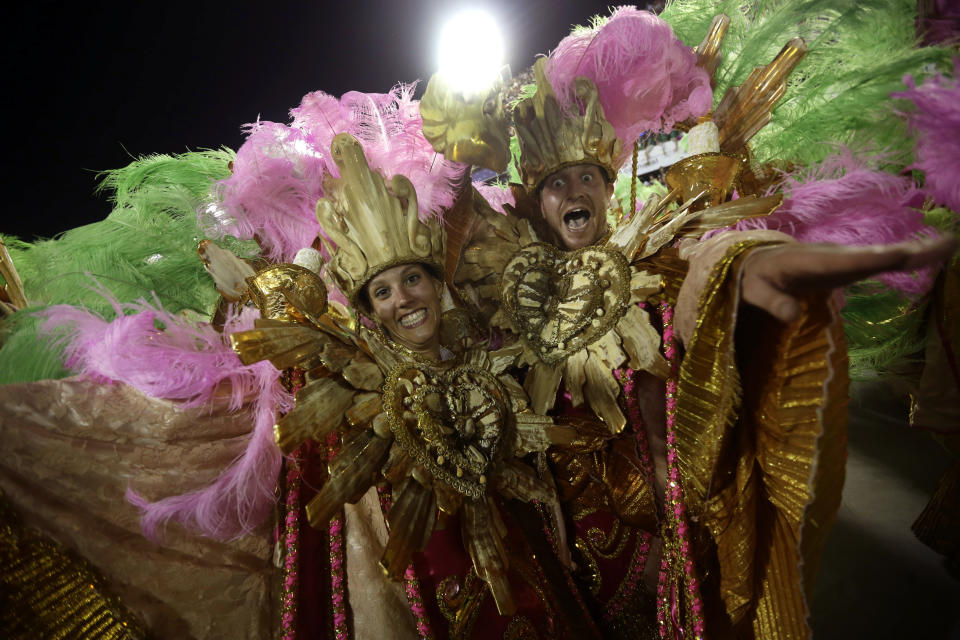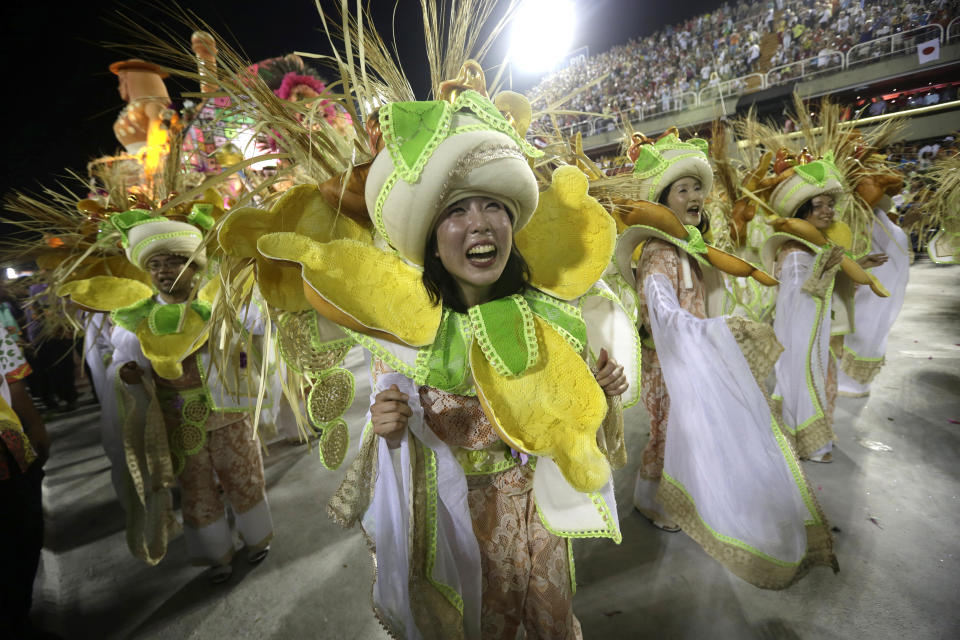Rio teacher out to prove 'gringos' can samba, too
RIO DE JANEIRO (AP) — With their gyrating hips and feet that move so fast they dissolve into a blur, samba instructor Carla Campos' students are barely distinguishable from the swarms of scantily clad dancers in Rio de Janeiro's Carnival parades. What's make them different is where they come from: abroad.
While non-Brazilians have long shelled out hundreds of dollars for the right to dress up in over-the-top costumes and boogie in Rio's samba school parades, which wrapped up Monday in an all-night extravaganza, few in the so-called "alas dos gringos," or "foreigners' wings," know how to dance the samba well. They tend to bop along goofily in the parades while waving at the crowds of spectators.
Campos' students, mostly blonde women from northern Europe and the United States who stand out in a land of dark-haired dancers, are a different story altogether. Campos has built a career out of debunking the widespread myth that only those born and bred in Rio, the birthplace of samba, can actually learn the notoriously complicated and lightning-fast dance.
"I swear I have seen foreigners who not only danced as well as your average person here in Rio, but some who are even better than good dancers from here," said Campos, looking the part of a samba instructor in her unitard with white and electric blue stripes. "Sure, it's a hard dance, but it's ridiculous to think there's anything genetic to it. It's about hard work."
At her studio in Rio's tony Ipanema neighborhood, Campos puts her students through their paces. They file in, swapping their sundresses and sandals for leotards, flippy little skirts and the towering but sturdy platforms required for samba.
Class starts with a series of hip-rolling exercises meant to limber up the pelvic region, where all samba's fancy footwork has its origins.
By minute 10 of the 50-minute lesson, sweat pours down the dancers' faces — and that's before the sambaing actually gets going in earnest. Once the feet start moving, beating an ever-accelerating tac, tac, tac rhythm into the parquet, the air conditioned studio becomes a sauna.
Campos developed her patented SambaFit workout, which combines samba steps with aerobics, about a decade ago. The idea for the class, which she also teaches at two high-end Rio gyms, was born during a trip to Finland, where she discovered a whole sub-culture of die-hard samba enthusiasts.
"The Finns were so passionate about it, they knew more about samba and danced better than many people here," Campos said, adding that those from Rio's moneyed elite have long tended to look down their noses at the samba as the dance of the lower classes. "I thought, 'we have this dance that people around the world think is marvelous, so we Brazilians have to learn to respect it, too.'"
Through her Finnish connections, Campos began giving private lessons to foreigners living in Rio. At first she had just a handful of expatriate students, but Brazil's galloping economy and massive off-shore oil discoveries have flooded the city with foreign workers in recent years.
When Campos opened her studio last year, a roster of around 40 students, all of them women and nearly all of them foreigners, followed her. Most have husbands or partners who were transferred to Brazil and are here on spouse visas that don't allow them to work.
"A lot of my students have had a really rough time integrating. They don't speak Portuguese and haven't made many friends here," said Campos, who gives the lessons in Portuguese, with a healthy dose of hand gestures and a sprinkling of simple English words. "Samba is their way of integrating Brazilian culture, and they throw themselves into learning how to dance it well."
That dedication is clear at the lessons. Even the shyest of students stare themselves down fiercely in the mirror, as if willing themselves to nail the steps. So much effort goes into the getting this that Campos periodically has to remind some to stop scowling and smile.
Despite the heat and the intensity of their concentration, every face in the class lights up when they rehearse the routine and song the group performed at the Sambadrome last week with the Academicos da Rocinha samba school. Feet get thrown into high gear. Faces are frozen into beaming smiles, and even those who can barely muster a "hello" in Portuguese belt out the lyrics to the school's theme song with gusto.
Student Mandy Gulbrandsen, a 37-year-old mother of one from Salem, Oregon, radiates excitement.
"I never, ever imagined I'd be dancing in Carnival in a costume that's so small that I should be wondering where it went," said Gulbrandsen, who moved to Rio about a year and a half ago with her husband, who works for Merrill Lynch. "I danced ballet and tap as a kid and that helps, but nothing prepares you for this."
Gulbrandsen said it took her about 10 lessons to manage to dance anything even vaguely resembling the samba. Her British-born classmate Jane Strachey said it's taken her even longer.
"I've been taking classes for about a year, and my moves have definitely improved but I have to face the fact that I'm never going to dance like a Brazilian," said Strachey, who moved here with her husband two years ago. "When I went to my first Carnival, I thought these girls were so beautiful and I wanted to be able to dance like them."
"And 12 months later, I am, but 'gringo' style," she said, employing the Portuguese word Brazilians use to refer to all foreigners.


